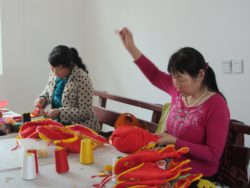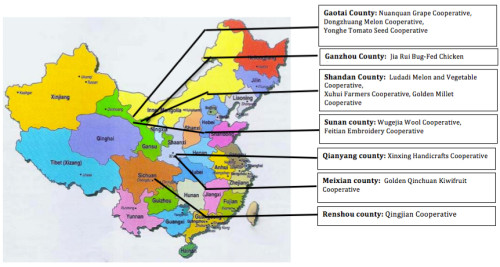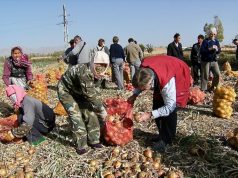
NZCFS can be justly proud of the amazing work it has done in recent years to support over 50 co-operatives in its NW and Central China Poverty-alleviation Project.
A book published at the end of 2014: “Co-operative Case Studies”, was written by Liu Guozhong and Tim Zachernuk. Both have spent the years since 2006 setting up and advising on the development of co-operatives, and have learned a huge amount of expertise on the way. Click HERE for their profiles.
Introduction
We have divided the book into three parts on our website:
‘Co-operative Case Studies Part 1’ (see below) starts with the reasons and history of setting up co-operatives in China. Also included are Rewi Alley’s work and that of ICICC (aka Gung Ho) in starting co-operatives.
Part 2 covers illustrated case histories of 12 out of the 50 co-operatives the Society has been directly involved with.

The authors selected those co-operatives with which we have had long term contact, often through several different projects. [We haven’t been able to keep in contact with all of the co-operatives which have participated in training activities].
Secondly, the authors wanted to cover a variety of sectors – animal husbandry, fruit, grain, handicrafts etc. They also aimed to “get a bit of a geographical spread”: covering co-operatives in 3 different provinces – Gansu, Shaanxi and Sichuan.
Besides detailing the nuts and bolts of the story of the development of each co-operative, the personal and often moving stories of the people who were prime movers are given, often in their own words.
Part 3 covers lessons learned by this work, advice on running co-ops, a Postscript and final analysis of the impact of this work.
The report shows how hugely successful this work has been. From initial doubt from some of the communities, they have moved on to: training potential leaders on management techniques,: improvement in co-ordinating advertising: sourcing new buyers; lowering costs and increasing profits, and gaining sufficient trust to collaborate with each other. As a result, there has been a phenomenal increase in numbers of participating members and families and an increase in wealth and pride for all.
All this is extremely satisfying, and word seems to have got around with an increased interest by other organisations in the techniques we have developed.
The Society’s Role:
NZCFS’s role started with Bill Willmott, when he visited Shandan in 2003. He emphasised the need for the Society to help in the development of co-operatives to carry on the tradition of our famous founder, Rewi Alley. This was followed by the Society collecting and shipping a container of practical goods equipment for project office, including computer, printer, scanner, to Shandan.
Work in setting up co-operatives began in 2005 when Dave Bromwich got funding for the first of many similar projects. Until recently, much of the initial funding was raised by, or donated to, the Society. New Zealand government funding by VASS (which became KOHA) quadrupled the amount.
Dave Bromwich along with Liu Guozhong , designed the training projects.
These were so successful that other communities “wanted to get in on the act”.
Unfortunately, since 2013, NZ Government aid has effectively dried up. But, fortunately, a Chinese business man, Mr He Wanying, is stepping into the breach with both practical and financial support.
The Society hopes that the approach described in this book will attract interest from Chinese local government and world-scale organisations such as the United Nations Development programme. Indeed, it is hoped that publishing this book will help considerably in spreading the techniques we have developed to make the role of co-ops in rural communities a widespread success.
We also wish to take this opportunity to show the Society’s appreciation for the help we have had from Gansu, Shaaxi and Sichuan Women’s Federation, as well as for the co-operation we have had from the ICICC (Gung Ho) throughout.
To help on the Chinese side, a Chinese version has been published. It has a different emphasis, including lessons, exercises and discussion points in training sessions, with advice on tools used for management training.
Both versions of “Co-operative Case Studies”, English and Chinese, were funded by the RAFE Fund.
Co-operative Case Studies – Part 1
Certain aspects of China are rarely covered in mainstream media and this report satisfies one of the aims of NZCFS: to provide greater understanding between China and NZ. China is now the largest economy in the world and much has been said about her phenomenal rise and economic development, but little about the rural part of China. Often the under-developed western part of China stands in stark contrast to the east, with the latter boasting every modern aspect of life in a rich country in which shopping malls and bullet train services abound. This report tells the other side, the story of farmers in the underdeveloped west who are struggling to come into the 21st century, indeed who are still battling to survive.
Background to rural China and Chinese co-operatives
For Westerners, it is difficult to imagine the huge changes in rural China since 1949. A 65-year-old farmer will have seen the country unified under a single government after decades of strife, foreign invasion and civil war. Poor farmers and landless labourers were given access to land but in the 1950’s this was followed by collectivisation of the rural economy and the creation of Peoples’ Communes. Then, in the early 1980’s, they experienced de-collectivisation and the introduction of family responsibility whereby they worked their own land parceled out to them in small plots. Finally, the last 36 years have brought rapid modernisation, unprecedented in China’s history, making it the largest economy in the world. Living standards and future prospects have improved beyond belief.
In the 80’s and 90’s, the marketing of farmers’ produce was done by individual farmers in small local markets, middlemen and also by traders travelling through the countryside. These men would buy from individual farmers and take the produce to a more distant destination, with products often passing through several traders before it reached its final destination. Traders would try to squeeze the prices paid as low as possible, and often the farmers got the short straw of the transaction.
In 2001, with China’s entry into the World Trade Organisation, farmers became part of global trading systems where prices are driven by exchange rates and world markets, rather than set by government decree. For example, chicken wings from the USA are now sold in China’s supermarkets competing with domestically-produced poultry, and also energy and fertiliser are subject to international market fluctuations, increasing the risks that farmers face. Vast improvements in transport and logistics have also fundamentally altered markets for agricultural products.
With modernisation, changes have also come in consumption habits. In 1980, 80% of China’s population was rural. By 2010, 50% of the population were living in cities with different buying habits from those of their rural neighbours. The first supermarket in China opened in 1990, but they are now all over the country. Supermarkets purchase large volumes and products must be able to be traced to its place of origin, requiring producers to keep detailed records. Small farmers can’t access these supply chains.
With increased incomes, consumers’ buying habits have changed. They buy more meat, fruit and vegetables and less grain, and demand higher quality, more variety with certified food safety. They are also looking for new products.
Despite China’s growth, poverty remains a serious problem in western China, especially in rural areas. Western China accounts for only 28.7 percent of the population but contains 58.2 percent of China’s poor.
The New Zealand connection: Rewi Alley’s contribution
In 1927, Rewi Alley arrived in China in search of adventure and worked as a safety inspector for the fire department in Shanghai. During that time, he saw the terrible working conditions of labourers and the abuse of child labourers. He began volunteer work for China International Famine Relief Commissions, travelling to Hubei, Inner Mongolia and other areas and this experience gave him a strong empathy for ordinary Chinese people and for the Communist movement in their efforts to address the conditions. The report gives details of his life and work in China.
Rewi Alley passed away in Beijing in December 1987 after more than half a century working to improve the lives of the poor and underprivileged in rural China. His legacy continues in the revitalized Gung Ho International organisation, in the Shandan Bailie School and in the support that both have given to the development of co-ops. The report covers, in full, the fascinating life of Rewi Alley and this edited version is a small sample of what is covered.
There have been many changes in the law on co-ops which have grown markedly in number and this is covered in the report, as well as the need for expert advice for those wishing to set up co-ops. NZCFS’ part in supporting Chinese co-operative development is then explained.
The above is an abridged version of the first part of the report. To download a pdf of the complete Part 1 of Co-operative Case Studies – Background to rural China and Chinese co-operatives: click Co-operative Case Studies – Part 1.
For Part 2 of Co-operative Case Studies – Case Studies of 12 Co-ops, click HERE.
For Part 3 of Co-operative Case Studies – Case Studies of 12 Co-ops, click HERE.
Teri France




